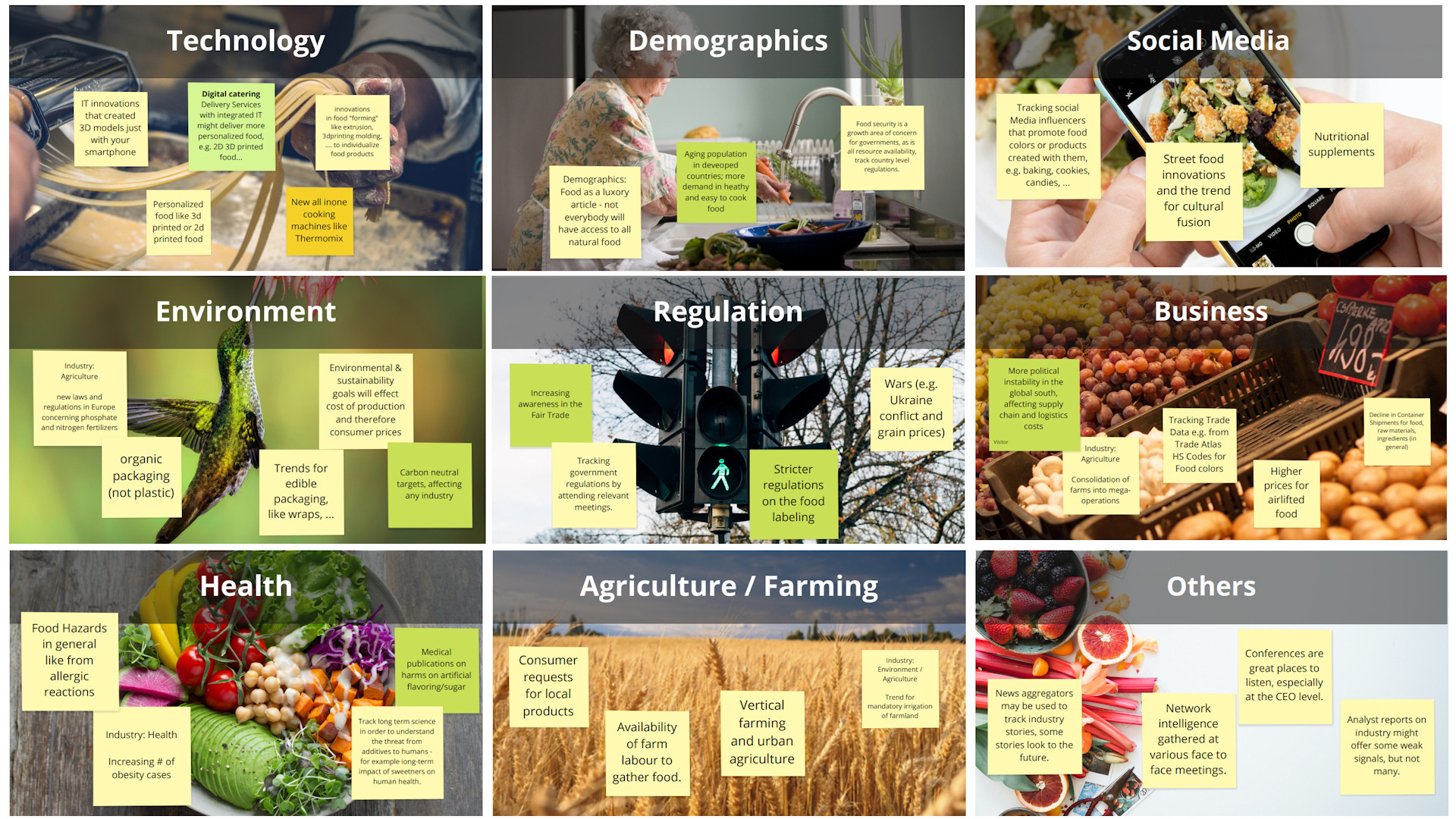Early Warning Signals within the Food Industry 2023

The food industry is constantly evolving due to changing consumer preferences, technological advancements, and regulatory developments. To adapt and thrive in this dynamic landscape, businesses must stay ahead of these changes. One way to do this is by keeping an eye on early warning signals within the industry. These signals can help businesses anticipate shifts in consumer preferences and adapt their product offerings accordingly.
In our Early Warning Analytical Case Challenge, which was part of our International Competitive and Market Intelligence Conference 2023, we identified potential early warning signals in a brainstorming session and categorized them into nine search fields.
Later, we discussed whether these potential trends and signals might affect the company in our case study, elaborated on specific sources to track weak signals, and spoke about some guidelines and rules of thumb for implementing an early warning system.
It’s important to keep in mind that real-world early warning systems are not built in 90 minutes, as we did in our brainstorming session. However, starting to build an early warning system can help businesses understand the complexity as well as the pros and cons of early warning systems.
Results of the brainstorming session
Technology will play a significant role in the food industry
- The emergence of new all-in-one cooking machines like Thermomix that combine multiple cooking functions into a single appliance.
- The rise of 3D printing and its application in the food industry which has the potential to revolutionize the way food is prepared and consumed.
- The integration of IT systems in delivery services which can offer more personalized and efficient food delivery experiences.
Demographics can will have a significant impact on
- The aging population in developed countries is leading to more demand for healthy and easy-to-cook food. Businesses that are able to adapt to this trend may be able to capture a larger share of the market.
- Food is becoming a luxury item, and not everybody will have access to all-natural food. This trend is likely to continue, and businesses that are able to offer affordable and sustainable food options may be able to capture a larger share of the market.
- Food security is a growing area of concern for governments, as is all resource availability. It’s important to track country-level regulations to ensure that businesses are able to operate effectively and efficiently.
Social Media is an important source for week signals
- Tracking social media influencers that promote food colors or products created with them, such as baking, cookies, candies, etc., can provide valuable insights into future consumer demands
- Nutritional supplements are another early warning signal related to social media within the food industry. With the rise of health and wellness trends, consumers are increasingly looking for ways to supplement their diets with vitamins and minerals.
- Street food innovations and the trend for cultural fusion are also important early warning signals related to social media within the food industry.
Sustainability and environmental issues are becoming increasingly important for businesses across all industries.
- New laws and regulations in Europe concerning phosphate and nitrogen fertilizers: Governments around the world are introducing new laws and regulations aimed at reducing the environmental impact of agriculture. For example, new laws in Europe concerning phosphate and nitrogen fertilizers are designed to reduce nutrient pollution in waterways.
- Environmental and sustainability goals will affect the cost of production and therefore consumer prices: As consumers become more environmentally conscious, businesses that fail to adopt sustainable practices may find themselves at a disadvantage. For example, businesses that rely heavily on fossil fuels may face higher costs as governments introduce carbon taxes or other measures aimed at reducing greenhouse gas emissions.
- Organic packaging (not plastic): Consumers are increasingly looking for products that are packaged in environmentally friendly materials.
- Carbon-neutral targets affecting any industry: Governments around the world are introducing carbon-neutral targets aimed at reducing greenhouse gas emissions.
- Trends for edible packaging, like wraps: Consumers are increasingly looking for products that are packaged in environmentally friendly materials.
Regulatory changes can have a significant impact. Some of the early warning signals related to regulation include:
- Increasing awareness in the Fair Trade: Consumers are becoming more aware of the importance of fair trade practices and are increasingly looking for products that are ethically sourced and produced. This trend is likely to continue, and businesses that fail to adapt may find themselves at a disadvantage.
- Wars (e.g., Ukraine conflict and grain prices): Conflicts and geopolitical tensions can have a significant impact on commodity prices, which can in turn affect businesses across various industries. For example, the ongoing conflict in Ukraine has led to higher grain prices, which has affected food manufacturers and other businesses that rely on grain as a key input.
- Tracking government regulations by attending relevant meetings: Attending relevant meetings and keeping up-to-date with regulatory developments can help businesses anticipate changes in the regulatory environment and adapt their operations accordingly.
- Stricter regulations on food labeling: Governments around the world are introducing stricter regulations on food labeling to provide consumers with more information about the products they consume. For example, some countries require food manufacturers to include information about allergens or nutritional content on their product labels. Businesses that fail to comply with these regulations may face penalties or reputational damage.
Warly warning signals related to business include:
- Political instability in the global south can have a significant impact on businesses across all industries. This instability can affect supply chain and logistics costs, making it more difficult for businesses to operate effectively.
- Tracking trade data: Businesses can track trade data using tools such as Trade Atlas to identify potential disruptions in the supply chain.
- HS codes for food colors: HS codes can be used to track the import and export of food colors, which can help businesses anticipate changes in the regulatory environment.
- Consolidation of farms into mega-operations: The consolidation of farms into mega-operations can have a significant impact on the agriculture industry.
- Higher prices for airlifted food: Political instability and increasing CO2 taxation can lead to higher prices for airlifted food, which can affect businesses across various industries.
Health related signals include
- Food hazards: Food hazards such as allergic reactions can have a significant impact on consumer health. Businesses that are able to identify and address these hazards may be able to capture a larger share of the market.
- Medical publications on harms of artificial flavoring/sugar: Medical publications can provide valuable insights into the potential harms of artificial flavoring and sugar.
- Tracking long-term science: Tracking long-term science can help businesses understand the threat from additives to humans. For example, tracking the long-term impact of sweeteners on human health can help businesses anticipate changes in consumer preferences.
- Increasing number of obesity cases: The increasing number of obesity cases is a significant concern for businesses in the health industry
Agriculture and Farming will see considerable trends and change.
- Consumer requests for local products: Consumer requests for local products can have a significant impact on the agriculture industry.
- Trend for mandatory irrigation of farmland: The trend for mandatory irrigation of farmland can have a significant impact on the agriculture industry.
- Vertical farming and urban agriculture: Vertical farming and urban agriculture are emerging trends in the agriculture industry.
- Availability of farm labor to gather food: The availability of farm labor to gather food is a significant concern for businesses in the agriculture industry.
Further uncategorized signals and sources might include
- Conferences: Conferences are great places to listen, especially at the CEO level. Businesses that are able to attend conferences may be able to identify potential disruptions in the market.
- News aggregators: News aggregators can be used to track industry stories. Some stories look to the future and can provide valuable insights into potential disruptions in the market.
- Network intelligence gathered at various face-to-face meetings: Network intelligence gathered at various face-to-face meetings can provide valuable insights into potential disruptions in the market.
- Analyst reports on industry: Analyst reports on industry might offer some weak signals, but not many. Businesses that are able to stay up-to-date on these reports may be able to identify potential disruptions in the market.
Did you use early warning systems in the past or are you planning to look into this method in the future? Feel free to leave us a comment or drop us an
We also teach Early Warning Systems as part of of out training programmes (see below).


